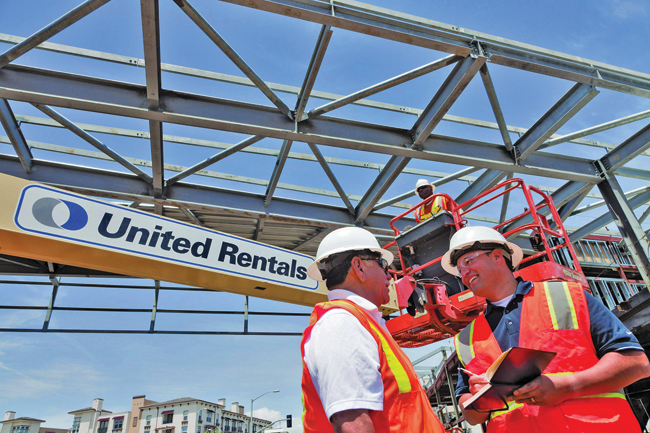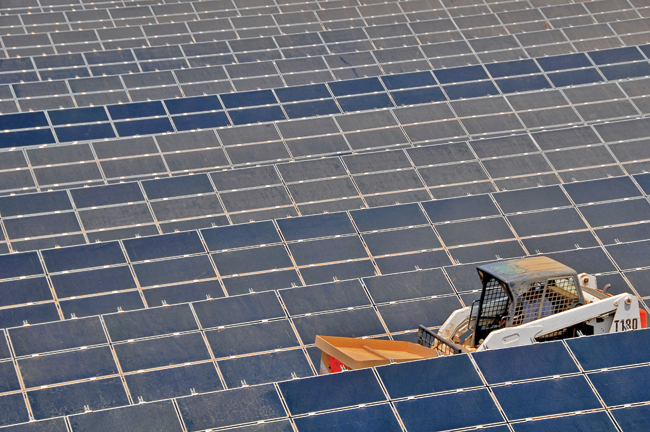Rental, Housing and Solar Are All on the Rise
Even though public spending is shrinking, there are positive signs of a construction recovery. In July President Obama signed a two-year, $105 billion transportation bill, bringing an end to a three-year fight over road and transit spending. Residential construction is coming back led by 30-plus percent growth in multi-family housing. Healthcare, energy and communications construction are all on the rise, and these niche surges are giving contractors new types of opportunities. Read about three similarly surging construction markets below.
Rentals Continue to Climb
While the economy is starting to recover, many construction companies are being cautious with their capital expenditures, meaning they are renting more equipment instead of owning it in recent years. In fact, many contractors have already begun to shift their equipment needs to rental. IHS Global Insight reports that 2011 saw a 7.9 percent growth in construction equipment rental revenue, significantly higher than 2010, when the U.S. construction industry as a whole was struggling. Construction and industrial equipment rentals outpaced gross domestic product (GDP) in 2011.

2010 and 2011 were good years for renting equipment, but the latest IHS Global Insight data forecasts that 2012 will be even better. According to recent data, the equipment rental industry’s forecasted revenue growth for this year is expected to increase by 9.8 percent, more than four times the growth forecasted for GDP in the United States this year.
Rental revenue growth is forecasted to continue in years to come as well. IHS Global Insight forecasts a construction growth of 8.6 percent in 2013 and skyrocketing by 15.8 percent in 2014. Rental revenue growth will increase 17.9 percent in 2015, resulting in an estimated $34.2 billion in rental revenue by 2016. The last peak of equipment rental revenue was in 2007, which was $25.4 billion, significantly lower than the predicted growth in the equipment rental industry. It’s safe to say that things are looking up for rental.
If you’re having trouble finding the right equipment you’re looking to rent, www.rentalhq.com is a reliable resource. Just enter what you need and where you need it, and you’ll find plenty of options near your location. It’s that simple. Information provided by Tom Hubbell, vice president of Marketing and Communications for the American Rental Association.
80 Improving Housing Markets
A total of 80 metropolitan statistical areas across 32 states and the District of Columbia were listed as improving housing markets on the National Association of Home Builders/First American Improving Markets Index (IMI) for August. This included 75 markets that retained their places on the list along with five new ones, while nine areas fell from the list due primarily to slight movements in house prices.
The index identifies metropolitan areas that have shown improvement from their respective troughs in housing permits, employment and house prices for at least six consecutive months. The five metros that were added to the list this month include: Miami and Palm Bay, Fla.; Hinesville, Ga.; Terre Haute, Ind.; and Lubbock, Texas.
“The fact that we continue to see a strong core of metros showing up on the improving list each month adds to the growing evidence that the emerging housing recovery has a solid foundation on which to build as housing returns to its traditional role of driving economic growth,” observed NAHB chief economist David Crowe.
“With nearly one quarter of all U.S. metros currently designated as improving housing markets, there is growing recognition among consumers that now is an opportune time to consider a home purchase,” added Kurt Pfotenhauer, vice chairman at First American Title Insurance Co.
The IMI is designed to track housing markets throughout the country that are showing signs of improving economic health. The index measures three sets of independent monthly data to get a mark on the top improving Metropolitan Statistical Areas. The three indicators that are analyzed are employment growth from the Bureau of Labor Statistics, house price appreciation from Freddie Mac and single-family housing permit growth from the U.S. Census Bureau. NAHB uses the latest available data from these sources to generate a list of improving markets. A metropolitan area must see improvement in all three measures for at least six months following those measures’ respective troughs before being included on the improving markets list.
A complete list of all 80 metropolitan areas currently on the IMI and separate breakouts of metros newly added to or dropped from the list in August is available at www.nahb.org/imi.
Solar Installations Swell
The U.S. Solar Market Insight: Q1 2012, a report released by GTM Research and the Solar Energy Industries Association (SEIA) in June, finds that growth in solar photovoltaics (PV) markets in the United States is maintaining its breakneck pace from 2011. Led by strong growth in the commercial market segment, the United States installed a record of 506 megawatts (MW) over the first three months of this year, more than any other first quarter on record.

This quarter’s activity brings the total amount of solar PV across America to 4,427 MW. In addition, concentrating solar power (CSP) facilities are providing 516 MW of electric power to the United States. Together, solar electric capacity reached 4,943 MW in the United States, enough to power 775,000 households.
“The U.S. solar industry continues to lead the United States out of difficult economic times,” said Rhone Resch, president and CEO of SEIA. “Installations have grown by 85 percent in the last year. This growth is coming from consumers who are turning to solar to reduce their energy costs. In states across the country, Americans are waking up to the realization that putting solar on your home or business is a better investment than the stock market.”
Overall, 2012 is shaping up to be another banner year for the U.S. solar market. The U.S. Solar Market Insight report forecasts total 2012 annual solar PV installations to exceed 3,200 MW. That’s 75 percent greater than last year’s total and 15 percent higher than previous annual forecasts for 2012. The increase in forecasted installations for 2012 is due to accelerated timelines for large-scale utility projects, greater-than-expected first quarter growth in the New Jersey commercial market, the number of safe-harbored projects that will still qualify for the U.S. government’s expired 1603 Treasury Program and overall positive outlooks for the California, Massachusetts and Hawaii markets.
“We remain bullish in 2012 on all market segments in the U.S. and most of the 23 states we cover in this report,” said Shayle Kann, vice president at GTM Research. “However, 2013 is an open question. The impacts of an import tariff on solar cells imported from China, as well as the expiration of the 1603 Treasury Program, will be felt most next year. This could coincide with a trough of demand in New Jersey and California’s adjustment period into a post-California Solar Initiative (CSI) world to create a temporary slowing of growth. However, we expect the U.S. market to regain momentum thereafter and continue along its path to become a global PV market leader by 2015.”For more information, visit www.seia.org.
